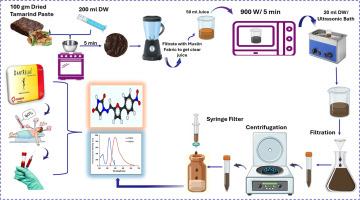Transforming a traditional ethnic beverage into highly emissive CDs as a sensitive nanosensor for the anti-malignant hyperthermia drug dantrolene sodium in pharmaceuticals and plasma. An economic and sustainable approach
IF 3.7
Q1 CHEMISTRY, ANALYTICAL
引用次数: 0
Abstract
This work provides a cost-effective, environmentally benign, rapidly prepared, highly fluorescent carbon dots (CDs) using renewable antioxidants-rich feedstock (Tamarindus Indica L.) as the precursor. A home-available and less energy-consuming microwave oven synthesizes CDs within 5 min. The created CDs have the highest fluorescence intensity at 402 nm after being excited at 328 nm, conferring a high luminescence quantum yield of 33.5 %. The prepared CDs provide ultra-sensitive and selective determination of dantrolene sodium (DAN), the only synthetic drug that can manage malignant hyperthermia up to now, and of extraordinary antioxidant properties. The determination is over a wide concentration range of (1.25–100.0 µM) with a limit of detection (LOD) and limit of quantification (LOQ) of 0.07 µM and 0.21 µM, respectively. DAN was estimated in two different pharmaceutical dosage forms, yielding percentage recoveries of 99.49 ± 1.50 and 99.74 ± 0.97. The proposed method was also successfully applied for the assay of DAN in spiked human plasma with a % recovery of 99.55 ± 3.13. Various greenness metrics were used to elucidate the greenness of the nanoprobe. The greenness of this work stems from the fabrication of CDs from natural, widespread, cheap, and edible fruit using a less energy and time-consuming, easily operated, and safe reactor. Moreover, avoiding harsh chemicals and solvents and using distilled water as the diluent renders the method greener. The above-mentioned facts about the proposed method prove it to be a validated analytical approach for different pharmaceutical and biological applications.

将传统民族饮料转化为高发射cd,作为药物和血浆中抗恶性热疗药物丹曲林钠的敏感纳米传感器。经济和可持续的方法
本研究提供了一种经济、环保、快速制备的高荧光碳点(CDs),该碳点以可再生的富含抗氧化剂的原料为前体。家用的低能耗微波炉可以在5分钟内合成cd。所制备的CDs在328 nm处激发后,在402 nm处荧光强度最高,发光量子产率高达33.5%。所制备的CDs具有优异的抗氧化性能,是迄今为止唯一用于治疗恶性高热的合成药物丹曲林钠(dantrolene sodium, DAN)的超灵敏和选择性测定。测定范围宽(1.25 ~ 100.0µM),检测限(LOD)为0.07µM,定量限(LOQ)为0.21µM。测定了两种不同剂型的DAN,回收率分别为99.49±1.50和99.74±0.97。该方法可用于加标血浆中DAN的测定,回收率为99.55±3.13 %。采用不同的绿色度指标来说明纳米探针的绿色度。这项工作的绿色源于用天然、广泛、廉价和可食用的水果制作cd,使用更少的能源和时间,易于操作和安全的反应器。此外,避免了苛刻的化学品和溶剂,并使用蒸馏水作为稀释剂,使该方法更加环保。上述事实证明,该方法是一种有效的分析方法,适用于不同的制药和生物学应用。
本文章由计算机程序翻译,如有差异,请以英文原文为准。
求助全文
约1分钟内获得全文
求助全文

 求助内容:
求助内容: 应助结果提醒方式:
应助结果提醒方式:


